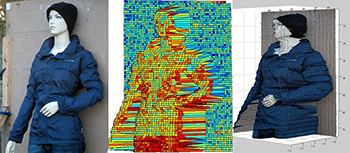
The lidar system captures depth profile measurements made in daylight on a mannequin. When mapped in 3-D from a range of 325 meters, a depth image can be reconstructed (center). The original photograph superimposed on the depth data (right). Credit: Heriot-Watt University
Scientists in Scotland have developed an imaging technique that can capture 3-D information of single photons at distances of a kilometer, adding to the remarkable progress of single-photon detectors in the past decade. Gerard Buller and colleagues at Heriot-Watt University in Edinburgh designed and tested a prototype multispectral lidar system using a time-correlated single-photon counting technique to recover millimeter-scale information about the structure and physiology of remote objects. The technique was tested on fir tree samples and was found to be practical for 3-D imaging from airborne and space-based imaging platforms (IEEE Trans. DOI: 10.1109/TGRS.2013.2285942).
The time-of-flight lidar system uses a supercontinuum laser source emitting simultaneously at 531 nm, 570 nm, 670 nm and 780 nm at a laser repetition rate of 2 MHz. Four thick-junction-silicon single-photon avalanche diode detectors construct 3-D images of targets a kilometer away using the absolute minimum of pulsed laser power—less than 200 µW total exiting the system. The system worked in bright sunny conditions to retrieve data less than 1 cm in resolution from a 3 mm beam spot.
“The solar background is by far the highest contribution to background which can swamp the return signal if the system is not engineered properly,” said Buller. “Even in Scotland, it is sunny occasionally!”
With an x-y system spatial resolution of 50 µrad and a z-resolution of 1 cm, such an array of single-photon detectors collects vast amounts of data in a time-efficient manner, but presents a bottleneck in data processing. According to Buller, more efficient imaging processing algorithms and recent work in “first-photon imaging” at MIT have shown a potentially exciting route to using less data, which reduces acquisition time and improves processing efficiency.
The researchers say the imaging technique has many applications, such as forest mapping for environmental study. The technique lends itself to imaging in scattering media, such as underwater depth imaging, collision monitoring in moving vehicles and a host of others in a wide variety of fields. Harnessing multi-spectral single-photon depth imaging from aircraft could provide an insight into the carbon cycle—but major issues remain in providing sufficient multi-spectral data from a moving platform.
